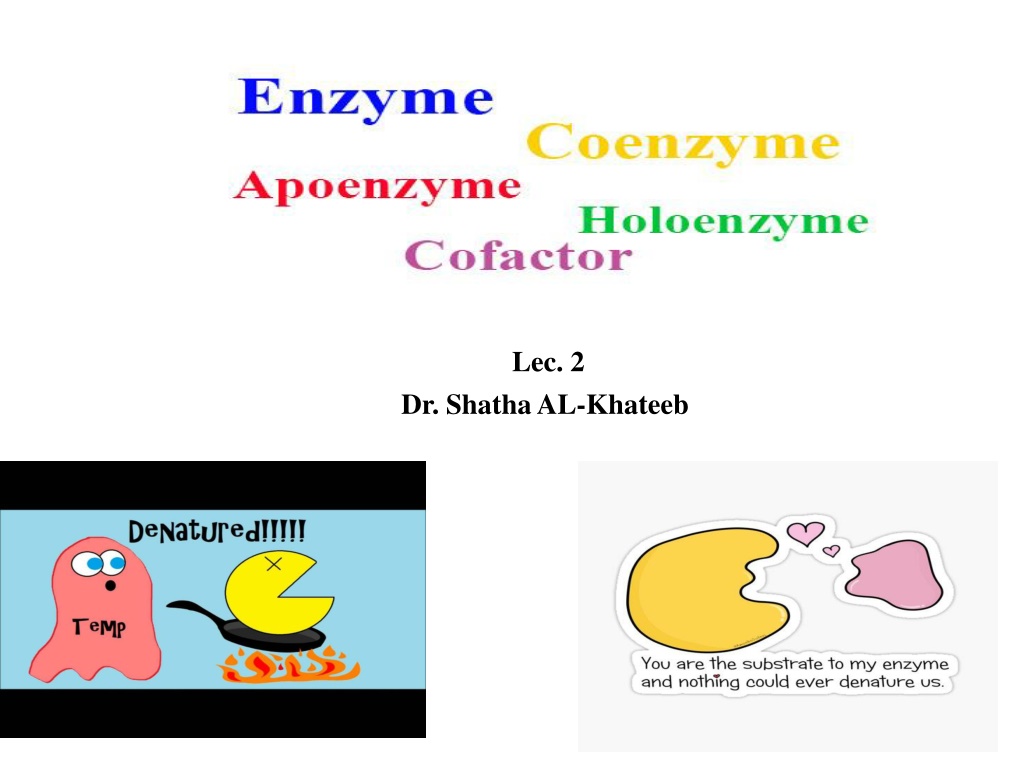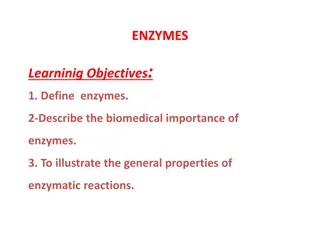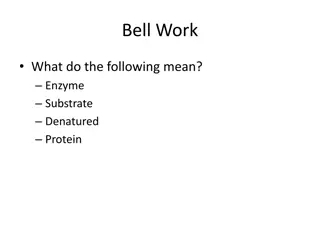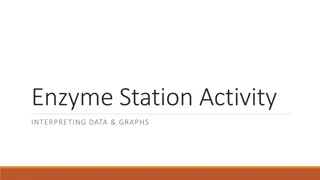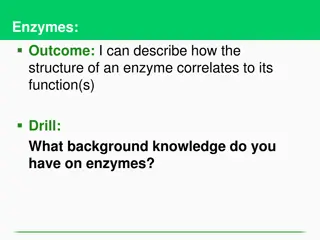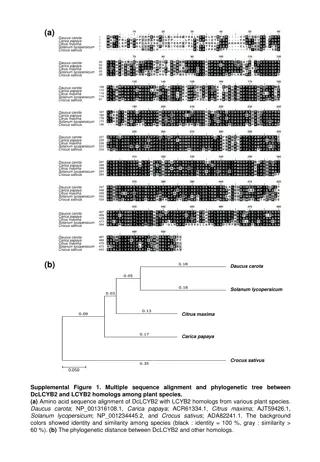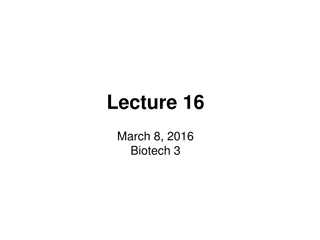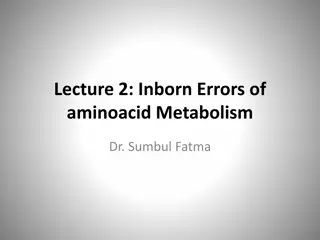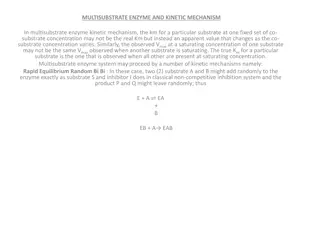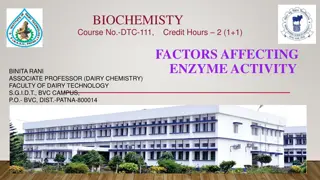Understanding Enzyme Function: The Key Steps and Importance of Cofactors
Enzymes play a crucial role in catalyzing biochemical reactions by forming enzyme-substrate complexes and facilitating changes in substrate molecules to product molecules. The process involves four steps: proximity of enzyme and substrate, binding at the active site, catalysis leading to substrate alteration, and product release. Substrate concentration affects reaction velocity, reaching a maximum at a certain point. Cofactors, both organic and inorganic, are essential non-protein components that, together with the apoenzyme, form holoenzymes crucial for enzymatic activity.
Download Presentation

Please find below an Image/Link to download the presentation.
The content on the website is provided AS IS for your information and personal use only. It may not be sold, licensed, or shared on other websites without obtaining consent from the author. Download presentation by click this link. If you encounter any issues during the download, it is possible that the publisher has removed the file from their server.
E N D
Presentation Transcript
Lec. 2 Dr. Shatha AL-Khateeb
Enzymes temporarily combine with the chemicals involved in a reaction. These chemicals are called the substrate. The combination is called the enzyme- substrate complex. When the enzyme and substrate combine, the substrate is changed to a different chemical called the product. The enzyme is not consumed or altered by the reaction.
Substrate Concentration It has been shown experimentally that if the amount of the enzyme is kept constant and the substrate concentration is then gradually increased, the reaction velocity will increase until it reaches a maximum. After this point, increases in substrate concentration will not increase the velocity (delta A/delta T).
Four Steps of Enzyme Action 1-The enzyme and the substrate are in the same area. Some situations have more than one substrate molecule that the enzyme will change. 2. The enzyme grabs on to the substrate at a special area called the active site. The combination is called the enzyme/substrate complex. Enzymes are very, very specific and don't just grab on to any molecule. The active site is a specially shaped area of the enzyme that fits around the substrate. It can only pick up one or two parts.
3. A process called catalysis happens. Catalysis is when the substrate is changed. It could be broken down or combined with another molecule to make something new. It will break or build chemical bonds. When done, it will have the enzyme/products complex. 4. The enzyme releases the product. When the enzyme lets go, it returns to its original shape. It is then ready to work on another molecule of substrate.
Cofactor A cofactor is the non-protein part of an enzyme that is essential for the enzyme s activity as a catalyst. Cofactors can bedifferentiated into organic and inorganic
Together with the apoenzyme (protein component), form the complete enzyme (holoenzyme). The removal of the cofactor from an enzyme results in the loss of enzymatic activity.
The cofactor is a large group that contains other groups like coenzymes and prosthetic groups depending on the groups characteristics. ,Organic cofactors include organic molecules like flavin, whereas inorganic cofactors include metal ions like Mg2+, Cu2+. The binding of cofactors to the protein unit of the enzyme also differs in different enzymes. Some cofactors are loosely bound to the apoenzyme, whereas some are bonded by covalent bonds.
Characteristics Cofactors Coenzymes Coenzymes are organic non-protein part of an enzyme which functions as cofactors for the function of catalysis. A cofactor is the non-protein part of an enzyme that is essential for the enzyme s activity as a catalyst. Definition The cofactor is a broader group that contains coenzymes and prosthetic groups. Cofactors are chemical compounds that can either be compounds, elements, or ions. Relationship Coenzymes are a type of cofactor. Coenzymes are molecules composed of multiple elements. Nature of the compound Cofactors can be organic or inorganic compounds. Coenzymes are organic molecules. Cofactors are either loosely bounded or covalently bonded to an enzyme. Nature of the bond Coenzymes are loosely bonded to enzymes. Coenzymes assist in the biological transformation of the enzyme for its function. Cofactors are essential for the function of the enzyme. Function Cofactors increase the rate of the reaction between the enzyme and the substrate. Cofactors participate in the removal of electrons, protons, or chemical groups from the substrate as a part of catalysis. Coenzymes serve as carriers to the enzymes. Coenzymes often remove electrons from the substrate and transfer them to other molecules. Role Inorganic cofactors can only be removed from the enzymes by denaturation of the enzyme. Coenzymes can be easily removed from the enzyme via chemical methods. Removal Cofactors can either be produced within the body or are consumed as a part of the diet. Coenzymes are produced within the body by different pathways. Production Examples of cofactors include metal ions like Zn2+, flavin, etc. Examples of coenzymes include vitamins, biotin, coenzyme A, etc. Examples
holoenzyme is an enzyme with its required cofactor; it functions the same as an enzyme Holoenzymes can be composed of many smaller parts called subunits
Apoenzyme is the protein part of an enzyme , are important for enzymatic activity since they are responsible for the specificity of enzymes to their substrates. Apoenzymes alone are not active enzymes; they must bind to an organic or inorganic cofactor in order to be activated.
Apoenzyme + Cofactor = Holoenzyme the cofactor may be: 1. A coenzyme - a non-protein organic substance which is dialyzable, thermostable and loosely attached to the protein part 2. A prosthetic group - an organic substance which is dialyzable and thermostable which is firmly attached to the protein or apoenzyme portion. 3. A metal-ion-activator - these include K+, Fe++, Fe+++, Cu++ ,Co++ , Zn++ , Mg++ ,Ca++ , and Mo+++
Coenzymes Metal ions (such as zinc or iron) are bound to enzymes and play central roles in the catalytic process. These molecules are called coenzymes because they work together with enzymes to enhance reaction rates. In contrast to substrates, coenzymes are not irreversibly altered by the reactions in which they are involved. Rather, they are recycled and can participate in multiple enzymatic reactions. Prosthetic groups are small molecules bound to proteins in which they play critical functional roles.
Coenzymes serve as carriers of several types of chemical groups. An example of a coenzyme is nicotinamide adenine dinucleotide (NAD+), which functions as a carrier of electrons in oxidation-reduction reactions . NAD+can accept a hydrogen ion (H+) and two electrons (e-) from one substrate forming NADH, then NADH can donate these electrons to a second substrate, re-forming NAD+. Thus, NAD+transfers electrons from the first substrate (which becomes oxidized) to the second (which becomes reduced). Many coenzymes are closely related to vitamins, which contribute part or all of the structure of the coenzyme. Vitamins are necessary components of the diets of human.
Examples of Coenzymes and Vitamins Coenzyme Related vitamin Chemical reaction NAD+, NADP+ Niacin Oxidation-reduction FAD Riboflavin (B2) Oxidation-reduction Thiamine pyrophosphate Thiamine (B1) Aldehyde group transfer Coenzyme A Pantothenate Acyl group transfer Transfer of one-carbon groups Tetrahydrofolate Folate Biotin Biotin Carboxylation Pyridoxal phosphate Pyridoxal (B6) Transamination
Specificity of Enzymes A few enzymes exhibit absolute specificity; that is, they will catalyse only one particular reaction. Other enzymes will be specific for a particular type of chemical bond or functional group. There are four distinct types of specificity: 1. Absolute specificity - the enzyme will catalyse only one reaction. 2. Group specificity - the enzyme will act only on molecules that have specific functional groups, such as amino, phosphate and methyl groups. 3. Linkage specificity - the enzyme will act on a particular type of chemical bond regardless of the rest of the molecular structure. 4. Stereochemical specificity - the enzyme will act on a particular steric or optical isomer
The Catalytic Activity of Enzymes An enzyme acts by lowering the activation energy of a chemical reaction, which increases the rate of reaction. The enzyme is not modified during the reaction. The initial molecules are the substrates of the enzyme, and the molecules formed from these substrates are the products of the reaction. Almost all metabolic processes in the cell require enzymes to run at a speed that is sufficient to sustain life.
Enzymes are characterized by two fundamental properties.First, they increase the rate of chemical reactions without themselves being consumed or permanently altered by the reaction. Second, they increase reaction rates without altering the chemical equilibrium between reactants and products. A molecule acted upon by an enzyme (as a substrate [S]) is converted to a product (P) as the result of the reaction. In the absence of the enzyme, the reaction can be written as follows:
The chemical equilibrium between S and P is determined by the laws of thermodynamics and is represented by the ratio of the forward and reverse reaction rates (S P and P S, respectively). In the presence of the appropriate enzyme, the conversion of S to P is accelerated, but the equilibrium between S and P is unaltered. Therefore, the enzyme must accelerate both the forward and reverse reactions equally. The reaction can be written as follows:
This is the role that enzymes play. They react with the substrate to form an intermediate complex a transition state that requires less energy for the reaction to proceed. The unstable intermediate compound quickly breaks down to form reaction products, and the unchanged enzyme is free to react with other substrate molecules.
Enzymatic catalysis of a reaction between two substrates. The enzyme provides a template upon which the two substrates are brought together in the proper position and orientation to react with each other.
Only a certain region of the enzyme, called the active site, binds to the substrate, which is a groove or pocket formed by the folding pattern of the protein. This three-dimensional structure, together with the chemical and electrical properties of the amino acids and cofactors within the active site, permits only a particular substrate to bind to the site, thus determining the enzyme s specificity.
The catalytic activity of enzyme involves the binding of their substrates to form an enzyme- substrate complex (ES) The substrate binds to a specific region(active site), then the substrate is converted into the product of the reaction, which is then released from the enzyme The active site is the region of an enzyme that binds substrates and catalyses an enzymatic reaction The enzyme-catalysed reaction can thus be written as follows
Note that E appears unaltered on both sides of the equation, so the equilibrium is unaffected. However, the enzyme provides a surface upon which the reactions converting S to P can occur more readily. This is a result of interactions between the enzyme and substrate that lower the energy of activation and favour formation of the transition state. Because the final energy state of P is lower than that of S, the reaction proceeds from left to right
Mechanisms of Enzymatic Catalysis The binding of a substrate to the active site of an enzyme is a very specific interaction. The Active sites are clefts or grooves on the surface of an enzyme, usually composed of amino acids from different parts of the polypeptide chain that are brought together in the tertiary structure of the folded protein(The three-dimensional folding of a polypeptide chain that gives the protein its functional form). Substrates bind to the active site by noncovalent interactions, including hydrogen bonds, ionic bonds, and hydrophobic interactions, when a substrate is bound to the active site of an enzyme, multiple mechanisms can accelerate its conversion to the product of the reaction.
Most biochemical reactions involve interactions between two or more different substrates. For example, the formation of a peptide bond involves the joining of two amino acids. The enzyme provides a template upon which the reactants are brought together and properly oriented to favour the formation of the transition state in which they interact.
Enzymes accelerate reactions by altering the conformation of their substrates to approach the transition state. The simplest model of enzyme- substrate interaction is the lock-and-key model, in which the substrate fits precisely into the active site . The configurations of both the enzyme and substrate are modified by substrate binding a process called induced fit. The conformation of the substrate is altered so that it more closely resembles that of the transition state, which is stabilized by its tight binding to the enzyme, thereby lowering the required energy of activation.
Models of enzyme-substrate interaction : A) In the lock-and-key model, the substrate fits precisely into the active site of the enzyme. (B) In the induced-fit model, substrate binding distorts the conformations of both substrate and enzyme. This distortion brings the substrate closer to the conformation of the transition state, thereby accelerating the reaction
The part of the enzyme where the substrate binds is called the active site. Enzymes are highly specific and will only bind one type of substrate, this is because an enzyme and substrate both possess specific complementary geometric shapes that fit exactly into one another. This is often referred to as "the lock and key" model. An enzyme only fits one particular kind of substrate in the same way that a lock only fits one particular kind of key.
